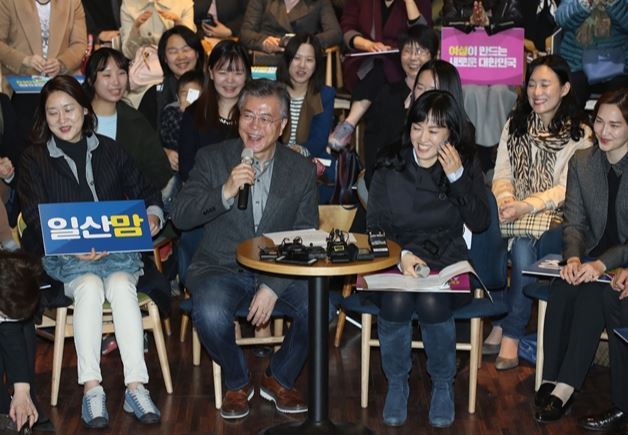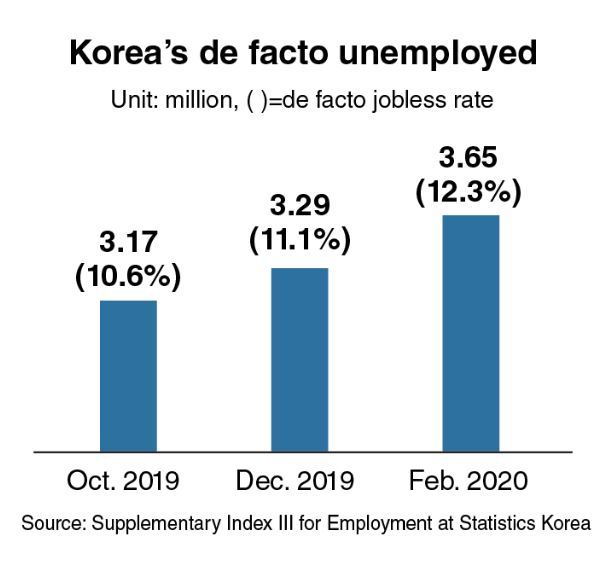[News Focus] Sagging economy seemingly put in backyard in election
1 in 8 economically active Koreans de facto jobless
By Kim Yon-sePublished : April 19, 2020 - 02:02

SEJONG -- Wednesay’s election de facto provided both the first and last opportunity for a large portion of voters in a fury to officially tackle the Moon Jae-in administration’s economic policies and judge its midterm performance via the ballot.
But the majority of effective ballots chose the ruling party in the 2020 general election. This means opponents of President Moon’s state affairs in the economic sector will have to wait two more years until March 9, 2022, which is the scheduled date of the next presidential election.
With the exception of feasible by-elections, if any, there are no major nationwide elections scheduled in the 23 months ahead until the 20th presidential election.
The majority of voters supported ruling party-oriented candidates during the 2018 local elections to back up the new administration, which had launched in May 2017. But since 2018, more and more people had apparently been on the lookout for the opportunity to express their anger toward Moon’s economic policies via the general election.
Their anger was estimated to have originated from high jobless rates, en masse business closures of self-employed people, reckless use of taxpayer money and failure in tackling skyrocketing apartment prices in Seoul, as well as the risks in fiscal soundness.

According to a series of surveys by major pollsters, “insolvent economic policies and performance” was the primary common factor among opponents of President Moon for the reason they were not supporting him or the ruling Democratic Party of Korea over the past approximately two years.
Some people have said the economic issue was put in the background, eclipsed by the COVID-19 disaster and its response during the parliamentary campaign.
Others refuted the theory, saying the approval gap between the Democratic Party and main opposition United Future Party (formerly the Liberty Korea Party) had continued to remain at 10 to 20 percentage points, with the latter failing to ever overtake the ruling party.
The overall trend in the public survey results has roughly been consistent since 2017.
Despite growing discontent with economic affairs, the approval gap was wide between younger and senior generations, between male and female respondents and by job positions.
By age and sex, the most faithful supporters of Moon and the ruling party were women in their 30s and 40s, while those with the most pessimistic stances were men in their 60s or older.
By job, a large portion of salaried workers support the incumbent administration, while the percentage of pessimistic assessment was high among the self-employed and housewives.
Advocates of Moon appeared to have put priority on establishing social justice over vitalizing the economy, polls showed.
An online commenter said that, irrespective of the election result, the administration should pay attention to the growing number of jobless people. He pointed out the unemployment data from Statistics Korea.
The database from the state–run agency shows that the Supplementary Index III for Employment reached 12.3 percent in February (the latest available figure), which marked the highest in 10 months since 12.4 percent in April 2019.
The figure of 12.3 percent indicates that 3.65 million of the economically active population, 29.7 million, are “de facto” out of work -- or about 1 in 8.
The Supplementary Index III for Employment, a new state method for calculation, regards “underemployed” people -- who work less than 36 hours a week and want to work more hours, as well as seasonal workers who are out of work for part of the year -- as jobless people.
In contrast, the “official” number of the jobless, publicized by the government, stayed at 1.15 million (only 4.1 percent in the nation’s unemployment rate) in February, which is fewer by 2.5 million than the de facto jobless.
According to the National Assembly Budget Office, the national debt came to 735.8 trillion won ($653.4 billion) as of April 16, compared to 392.2 trillion won a decade earlier in 2010, which is ringing alarm bells over Korea’s fiscal soundness.
In addition, the Korean currency is still showing weakness against the US dollar, the Japanese yen and many others, despite the global damage of the novel coronavirus.
By Kim Yon-se (kys@heraldcorp.com)









![[Kim Seong-kon] Democracy and the future of South Korea](http://res.heraldm.com/phpwas/restmb_idxmake.php?idx=644&simg=/content/image/2024/04/16/20240416050802_0.jpg&u=)







![[KH Explains] Hyundai's full hybrid edge to pay off amid slow transition to pure EVs](http://res.heraldm.com/phpwas/restmb_idxmake.php?idx=652&simg=/content/image/2024/04/18/20240418050645_0.jpg&u=20240418181020)

![[Today’s K-pop] Zico drops snippet of collaboration with Jennie](http://res.heraldm.com/phpwas/restmb_idxmake.php?idx=642&simg=/content/image/2024/04/18/20240418050702_0.jpg&u=)